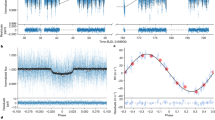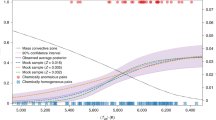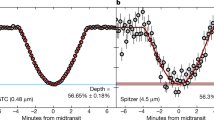Abstract
Current models1,2 of the evolution of the known extrasolar planetary systems need to incorporate orbital migration and/or gravitational interactions among giant planets to explain the presence of large bodies close to their parent stars. These processes could also lead to planets being ingested by their parent stars, which would alter the relative abundances of elements heavier than helium in the stellar atmospheres. In particular, the abundance of the rare 6Li isotope, which is normally destroyed in the early evolution of solar-type stars3 but preserved intact in the atmospheres of giant planets, would be boosted substantially. 6Li has not hitherto been observed reliably in a metal-rich star4,5, where metallicity refers to the total abundance of elements heavier than helium. Here we report the discovery of 6Li in the atmosphere of the metal-rich solar-type star HD82943, which is known to have an orbiting giant planet. The presence of 6Li can probably be interpreted as evidence for a planet (or planets) having been engulfed by the parent star.
This is a preview of subscription content, access via your institution
Access options
Subscribe to this journal
Receive 51 print issues and online access
$199.00 per year
only $3.90 per issue
Buy this article
- Purchase on Springer Link
- Instant access to full article PDF
Prices may be subject to local taxes which are calculated during checkout



Similar content being viewed by others
References
Weidenschilling, S. J. & Marzari, F. Gravitational scattering as a possible origin for giant planets at small distances. Nature 384, 619–621 (1996).
Lin, D. N., Bodenheimer, P. & Richardson, D. C. Orbital migration of the planetary companion of 51 Pegasi to its present location. Nature 380, 606–607 (1996).
Forestini, M. Low mass stars: Pre-main sequence evolution and nucleosynthesis. Astron. Astrophys. 285, 473–488 (1994).
Andersen, J., Gustafsson, B. & Lambert, D. L. The lithium isotope ratio in F and G stars. Astron. Astrophys. 136, 65–73 (1984).
Rebolo, R., Crivellari, L., Castelli, F., Foing, B. & Beckman, J. E. Lithium abundances and 7Li/6Li ratios in late-type population I field dwarfs. Astron. Astrophys. 166, 195–203 (1986).
Naef, D. et al. The CORALIE survey for southern extrasolar planets V. 4 new extrasolar planets. Astron. Astrophys. (in the press).
Santos, N. C., Israelian, G. & Mayor, M. Chemical analysis of 8 recently discovered extra-solar planet host stars. Astron. Astrophys. 363, 228–238 (2000).
Smith, V. V., Lambert, D. & Nissen, P. E. Isotopic lithium abundances in nine halo stars. Astrophys. J. 506, 405–423 (1998).
Hobbs, L. M., Thorburn, J. A. & Rebull, L. M. Lithium isotope ratios in halo stars. III. Astrophys. J. 523, 797–804 (1999).
Nissen, P. E., Lambert, D., Primas, F. & Smith, V. V. Isotopic lithium abundances in five metal-poor disk stars. Astron. Astrophys. 348, 211–221 (1999).
Kurucz, R. L., Furenlid, I., Brault, J. & Testerman, L. Solar flux atlas from 296 to 1300 nm. NOAO Atlas 1 (Harvard Univ. Press, Cambridge, Massachusetts, 1984).
Anders, E. & Grevesse, N. Abundances of the elements–meteoritic and solar. Geochim. Cosmochim. Acta 53, 197–214 (1989).
Lambert, D., Smith, V. V. & Heath, J. Lithium in the barium stars. Publ. Astron. Soc. Pacif. 105, 568–573 (1989).
Perryman, M. A. C. et al. The Hipparcos catalogue. Astron. Astrophys. Lett. 323, 49–52 (1997).
Ramaty, R., Tatischeff, V., Thibaud, J. P., Kozlovsky, B. & Mandzhavidize, N. 6Li from solar flares. Astrophys. J. Lett. 534, 207–210 (2000).
Chaussidon, M. & Robert, F. Lithium nucleosynthesis in the sun inferred from the solar-wind 7Li/6Li ratio. Nature 402, 270–273 (1999).
Müller, E. A., Peytremann, E. & De La Reza, R. The solar lithium abundance. II. Solar Phys. 41, 53–65 (1975).
Schaerer, D., Charbonnel, C., Meynet, G., Maeder, A. & Schaller, G. Grids of stellar models—Part four—from 0.8M⊙ to 120M⊙ at Z = 0.040. Astron. Astrophys. Suppl. 102, 339–342 (1993).
D'Antona, F. & Mazzitelli, I. New pre-main sequence tracks for M ≤ 2.5M⊙ as tests of opacities and convection models. Astrophys. J. Suppl. 90, 467–500 (1994).
Alexander, J. B. A possible source of lithium in the atmospheres of some red giants. Observatory 87, 238–240 (1967).
Ryan, S. G. The host stars of extrasolar planets have normal lithium abundances. Mon. Not. R. Astron. Soc. 316, L35–L39 (2000).
Balachandran, S. Lithium depletion and rotation in main-sequence stars. Astrophys. J. 354, 310–332 (1990).
Glass, B. P. Introduction To Planetary Geology (Cambridge Univ. Press, Cambridge, 1982).
Fields, B. D. & Olive, K. A. The evolution of 6Li in standard cosmic ray nucleosynthesis. New Astron. 4, 255–263 (1999).
Knauth, D. C., Federman, S. R., Lambert, D. L. & Crane, P. Newly synthesized lithium in the interstellar medium. Nature 405, 656–658 (2000).
Thi, W. F. et al. Substantial reservoirs of molecular hydrogen in the debris disks around young stars. Nature 409, 60–63 (2001).
Levison, H. F., Lissauer, J. J. & Duncan, M. J. Modeling the diversity of outer planetary systems. Astron. J. 373, 1998–2014 (1998).
Gonzalez, G., Laws, C., Tyagi, S. & Reddy, B. E. Parent stars of extrasolar planets VI: Abundance analyses of 20 new systems. Astron. J. 121, 432–452 (2001).
Boesgaard, A. M. & Tripicco, M. Lithium in early F dwarfs. Astrophys. J. 303, 724–739 (1986).
Jones, B. F., Fisher, D. & Soderblom, D. R. The evolution of the lithium abundances of solar-type stars. VIII. M67 (NGC 2682). Astron. J. 117, 330–338 (1999).
Acknowledgements
These observations were made possible through the DDT time granted on the VLT Kueyen by ESO. We thank the Swiss National Science Foundation and the Spanish Ministry of Science and Technology for continuous support for this project. Support from the Fundação para a Ciênca e Tecnologia, Portugal, and to N.C.S. in the form of a scholarship is acknowledged.
Author information
Authors and Affiliations
Corresponding author
Rights and permissions
About this article
Cite this article
Israelian, G., Santos, N., Mayor, M. et al. Evidence for planet engulfment by the star HD82943. Nature 411, 163–166 (2001). https://doi.org/10.1038/35075512
Received:
Accepted:
Issue Date:
DOI: https://doi.org/10.1038/35075512
This article is cited by
-
Doppler spectroscopy as a path to the detection of Earth-like planets
Nature (2014)
-
The Architectural Design Rules of Solar Systems Based on the New Perspective
Earth, Moon, and Planets (2011)
-
An orbital period of 0.94 days for the hot-Jupiter planet WASP-18b
Nature (2009)
-
PLATO: PLAnetary Transits and Oscillations of stars
Experimental Astronomy (2009)
-
On periodic orbits and resonance in extrasolar planetary systems
Celestial Mechanics and Dynamical Astronomy (2008)
Comments
By submitting a comment you agree to abide by our Terms and Community Guidelines. If you find something abusive or that does not comply with our terms or guidelines please flag it as inappropriate.



